Tips to Perfect Your Golf Stance
The Perfect Golf Stance: Put an End to Cringe-Worthy Golf Shots by Fixing Your Setup and Perfecting Your Posture
If your game is suffering, the first place to look is your golf stance.
Even a seemingly minor mistake in your golf stance can completely wreck your swing. From poor contact to the dreaded slice, a lot of bad shots begin with a bad setup.
The good news is that golf stance errors tend to be easy to spot and even easier to fix. I’m going to walk you through everything you need to know about getting set up for the perfect golf shot. We’ll take a look at:
- Golf posture
- Proper ball position
- Stance width
- Aim
- Weight distribution
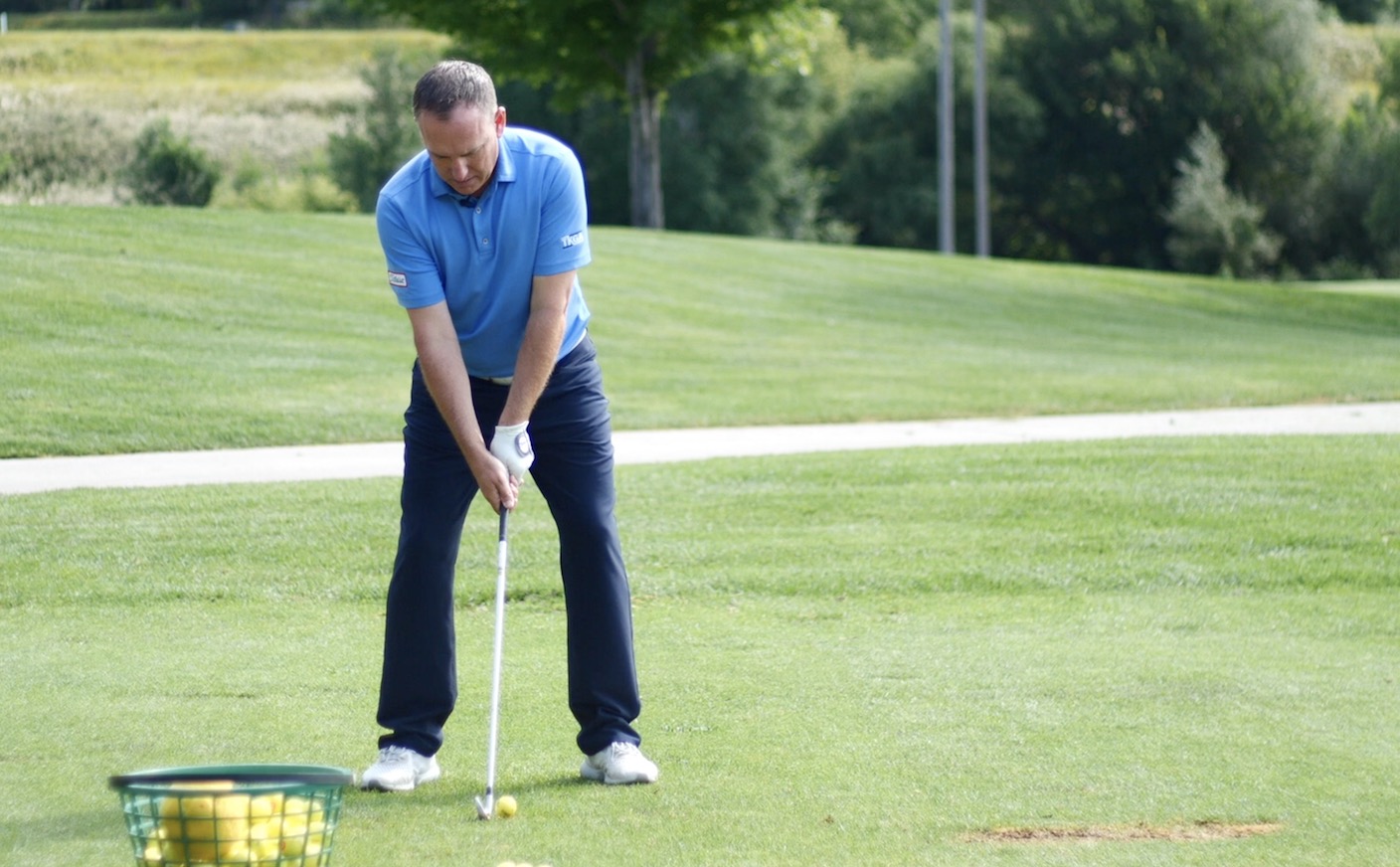
I’ll also highlight the differences between the ideal golf stance for irons and drivers. You’ll be able to pinpoint any mistakes you have been making, and you’ll be ready to hit the course with new confidence.
Let’s jump in.
Importance of Posture in Golf Swing
Even if you know the most essential golf swing basics, you aren’t going to get the shots you’re capable of if your golf posture is off.
Your golf posture affects your ability to rotate through your backswing. The right body angles can help you stay on your golf swing plane through your downswing.
On the flip side, poor posture can create a multitude of problems, from bad contact to poor face control.
Later, I’ll dig into some of the most common golf posture mistakes. For now, I want to highlight the one golf posture tip you need to know in order to set up your shot properly.
Let’s talk about the distance between yourself and the golf ball.
Distance
It may seem like a small detail, but it’s actually extremely important that you find the proper distance between yourself and the ball.
If the golf ball is too close to your body, you end up with too many angles in your golf posture. You might have an extreme bend in your elbows or too much rounding in the back and neck. This can definitely kill your range of motion and keep you from generating speed.
Or suppose you have too much distance. If your body is too far from the ball in your golf setup, you could find yourself too extended. Your arms become straight and tight throughout the swing. This is a definite recipe for trouble.
So, how do you know if you have the proper distance?
Well, it’s easier than you might think.
Simply put, you want your hands to fall directly below your shoulders in your setup. Here’s how to check if you’re in the right place:
- Take your regular golf setup with a slight forward spine tilt.
- Release your trail hand, allowing it to swing away from the club handle and back again. Don’t control the swing; just let gravity do its thing.
Your trail hand should naturally return to the club handle. And if it doesn’t?
- If your hand swings behind the club handle (closer to your body), you need to move slightly closer to the golf ball.
- Move back a bit if your hand swings in front of the club handle.
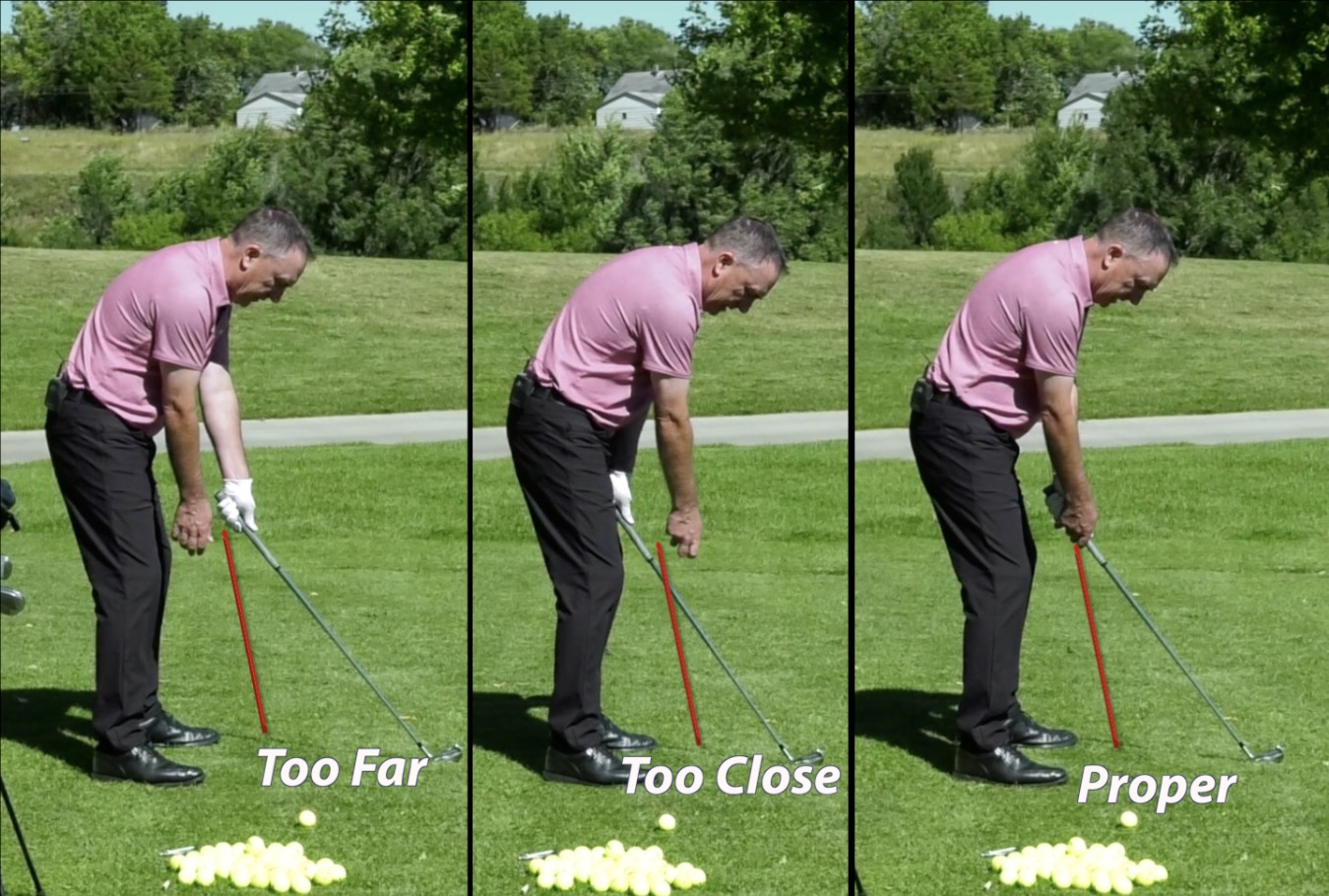
Once you have your distance figured out, you’re ready to dive in to the deeper details of golf stance.
Top Golf Stance Tips
If you have the correct distance between yourself and the golf ball and you’re still struggling with your iron shots, it’s time to look at other aspects of your golf stance. Check yourself for:
- Proper stance width and ball position
- Handle and hand position
- Aim
- Weight distribution
If you are making errors in any of these areas, the mistake is probably a small one. But when it comes to your golf stance, tiny errors can have major repercussions.
Let’s take a look at these aspects of your golf stance one-by-one.
Golf Stance Width and Ball Position
First, how wide should your golf stance be?
For iron shots, you want a shoulder-width stance.
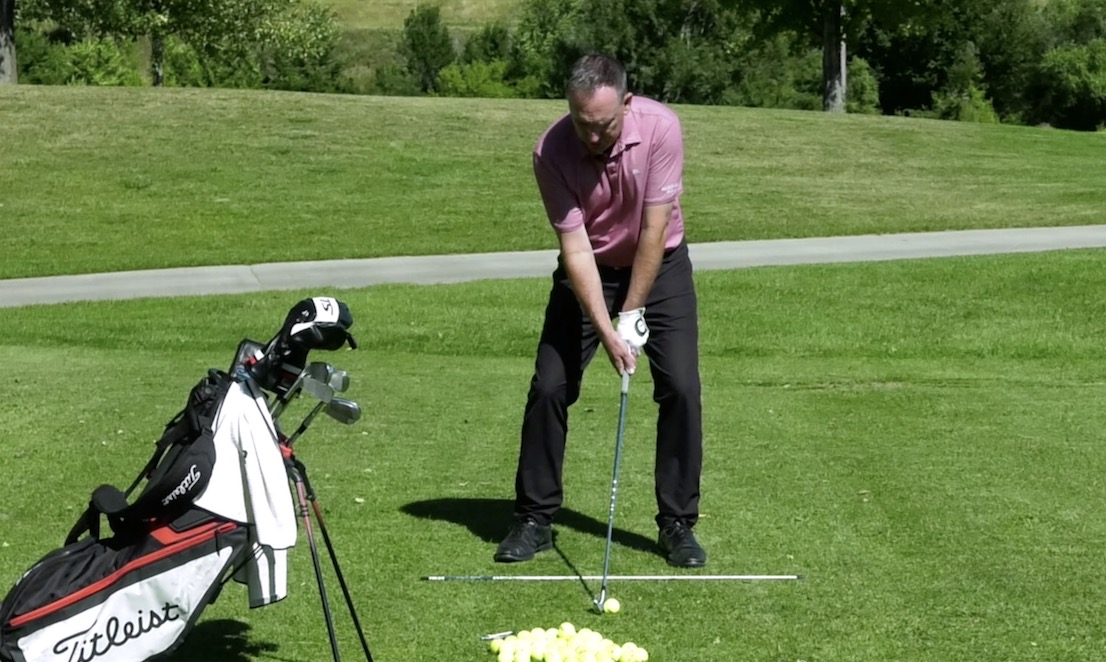
Now, where should the golf ball be positioned within that stance?
Golf ball position is one of the most important aspects of your setup. It’s especially important in your iron shots, because this type of shot comes with one very specific goal:
You want to catch the golf ball on a slight downward motion.
This means you need to make contact before the club head reaches the low point of your golf swing. To do that, you need the golf ball in the center of your stance.
Here’s an incredibly simple way to find center.
- Stand with your feet together and the golf ball aligned with the crack between your shoes.
- Step your lead foot toward the target so it’s even with your lead shoulder.
- Take your trail foot and step it away from the target so it’s even with your trail shoulder.
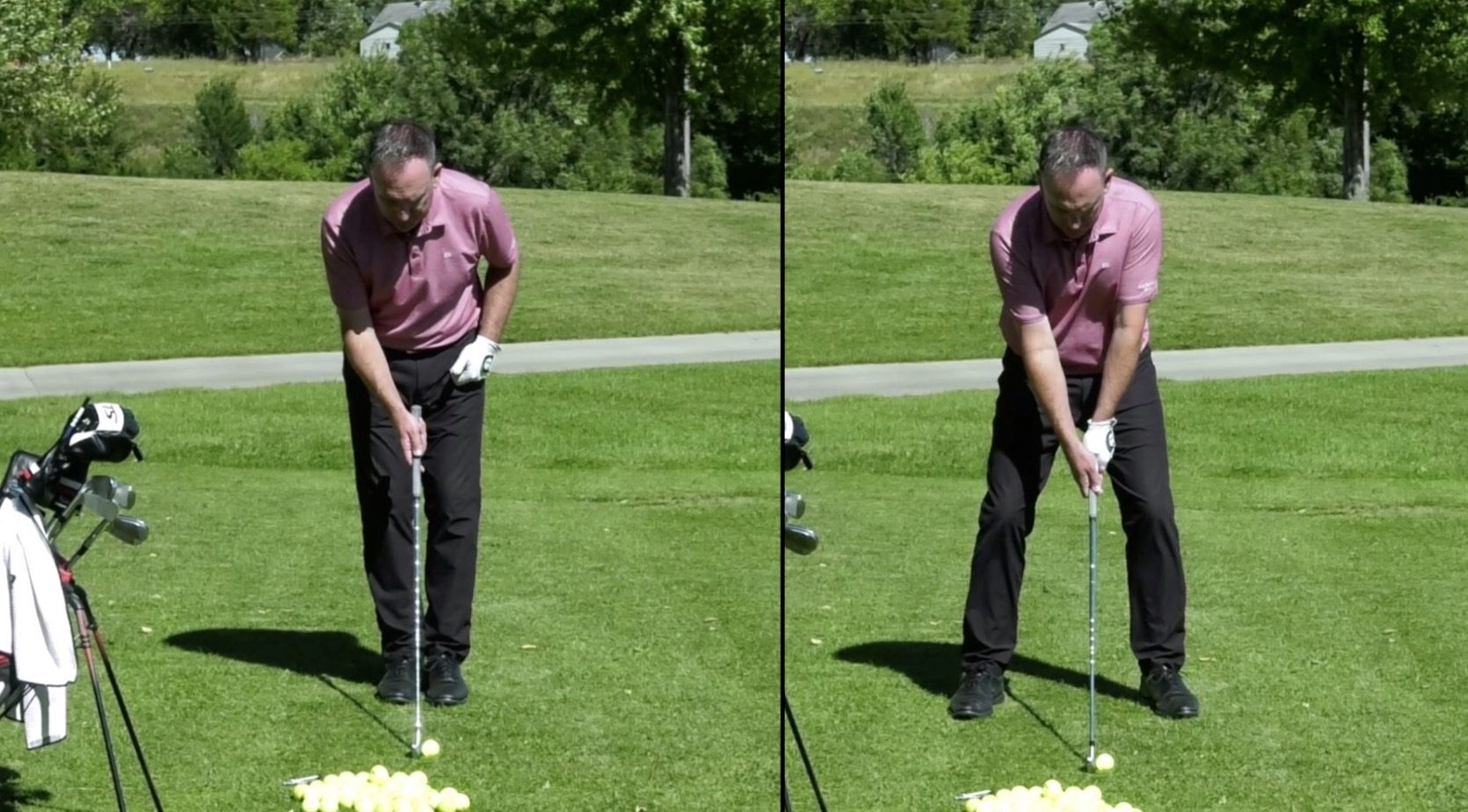
The ball should now be in the center of your golf stance.
Handle and Hand Position
A lot of amateur golfers don’t give hand position much thought, but it’s crucial for a perfect golf setup.
When you take your stance, check the position of your hands and club handle. Are they slightly behind your belt buckle? Is the club shaft leaning slightly away from the target?
If so, you’re making an error that a lot of golfers make, and it could explain your problem shots.
To fix this mistake, all you have to do is move your hands and club handle slightly forward, towards the target. The club handle should point to a spot between your belt buckle and the pants pocket on your lead hip.
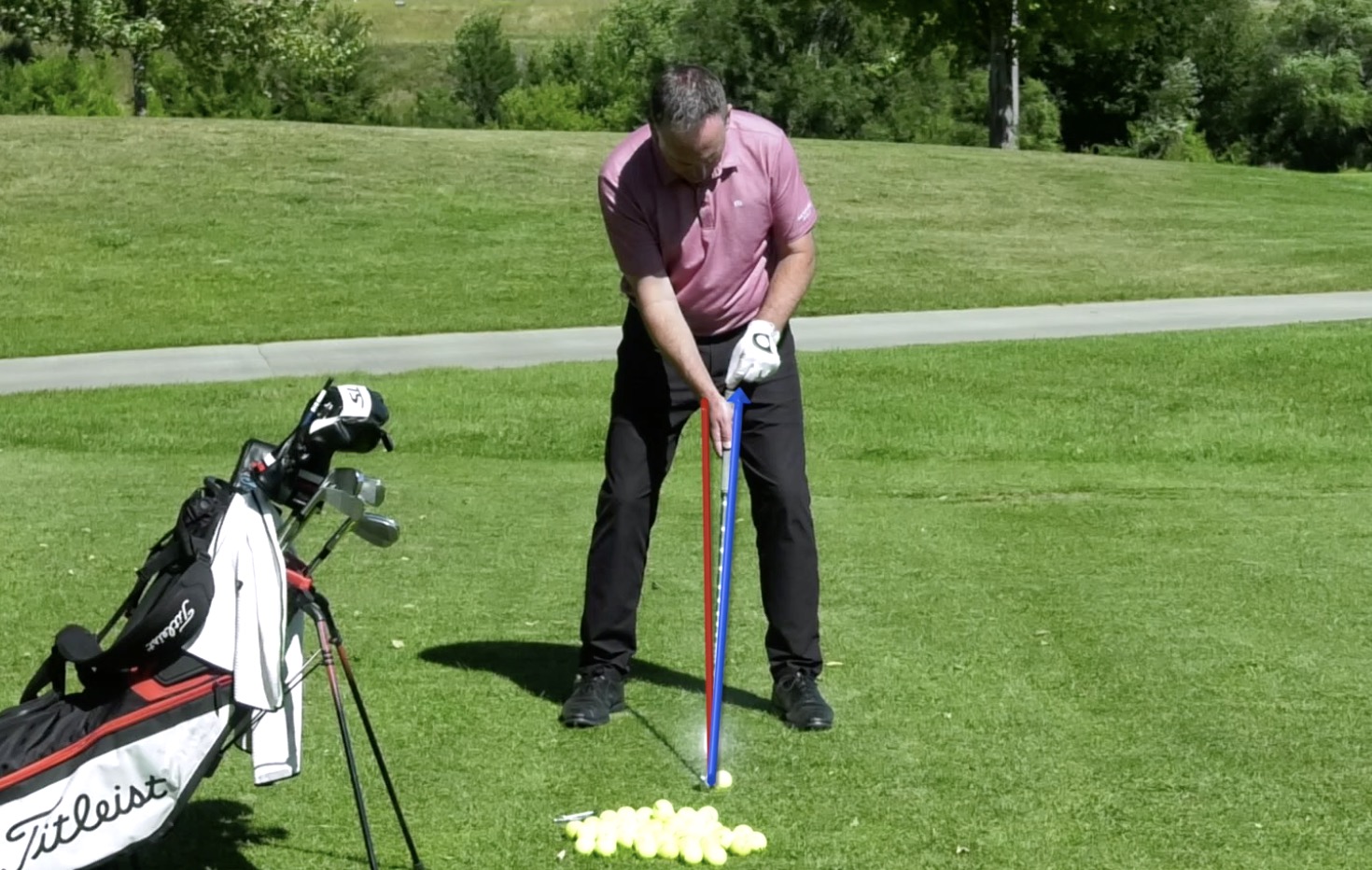
Setting Up Your Aim
If you’re concerned about mastering aim in your golf stance, you’re in good company. Because so many problem shots involve a wayward ball flight, a lot of golfers are eager to fix their aim.
Unfortunately, your first instincts for fixing your aim may be incorrect. If aim was the only element of your setup that affected flight path, correcting slices and hooks would be easier. But the slice, for example, is actually caused by a combination of swing path and face orientation.
That’s the bad news. Here’s the good news.
While the slice is complicated, fixing it is fairly simple. We have a lot of in-depth articles on how to fix the slice, but for now, I’ll focus on your setup.
I personally believe that you want to have a slight rightward aim bias in your golf stance. This is true for most golfers, but slicers especially benefit from this adjustment.
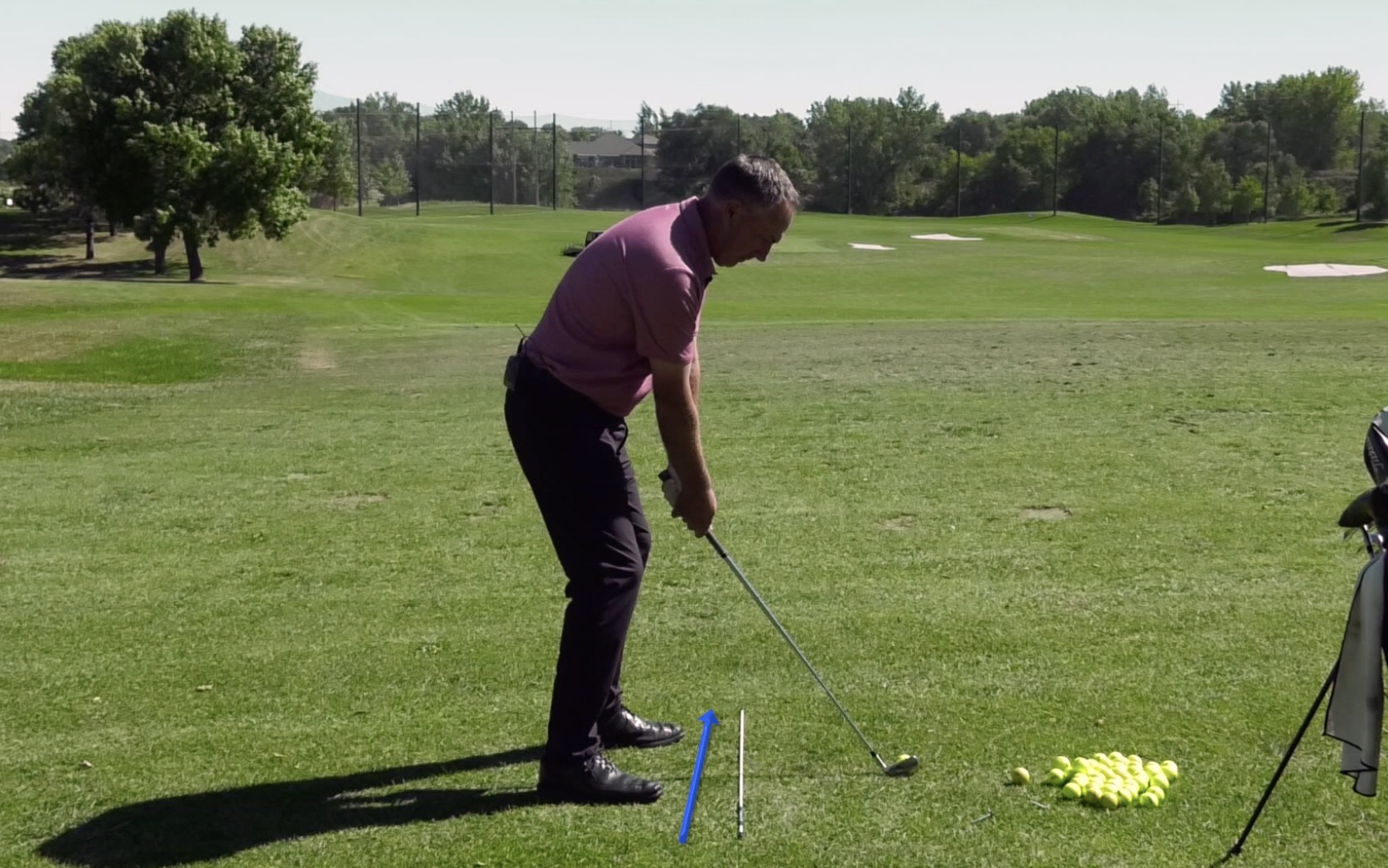
All you have to do to is aim slightly to the right of the target. This means shifting your feet so that if you drew a straight line across your toes, the line would extend out to the right of the target line. Do the same with your hips and shoulders.
To help my students visualize the rightward aim, I use an alignment rod. We position the alignment rod on the ground halfway between the golfer’s toes and their golf ball. The rod points to the target, giving the student a clear visual of where the target line is.
Using this reference point, the student can then shift their feet, hips, and shoulders to aim slightly right of that target line.
Weight Distribution
The best golfers start with more weight on their lead foot. This is a scientific fact. We’ve even tested touring professionals here in our lab. They all start with more pressure in their lead foot than in their trail foot.
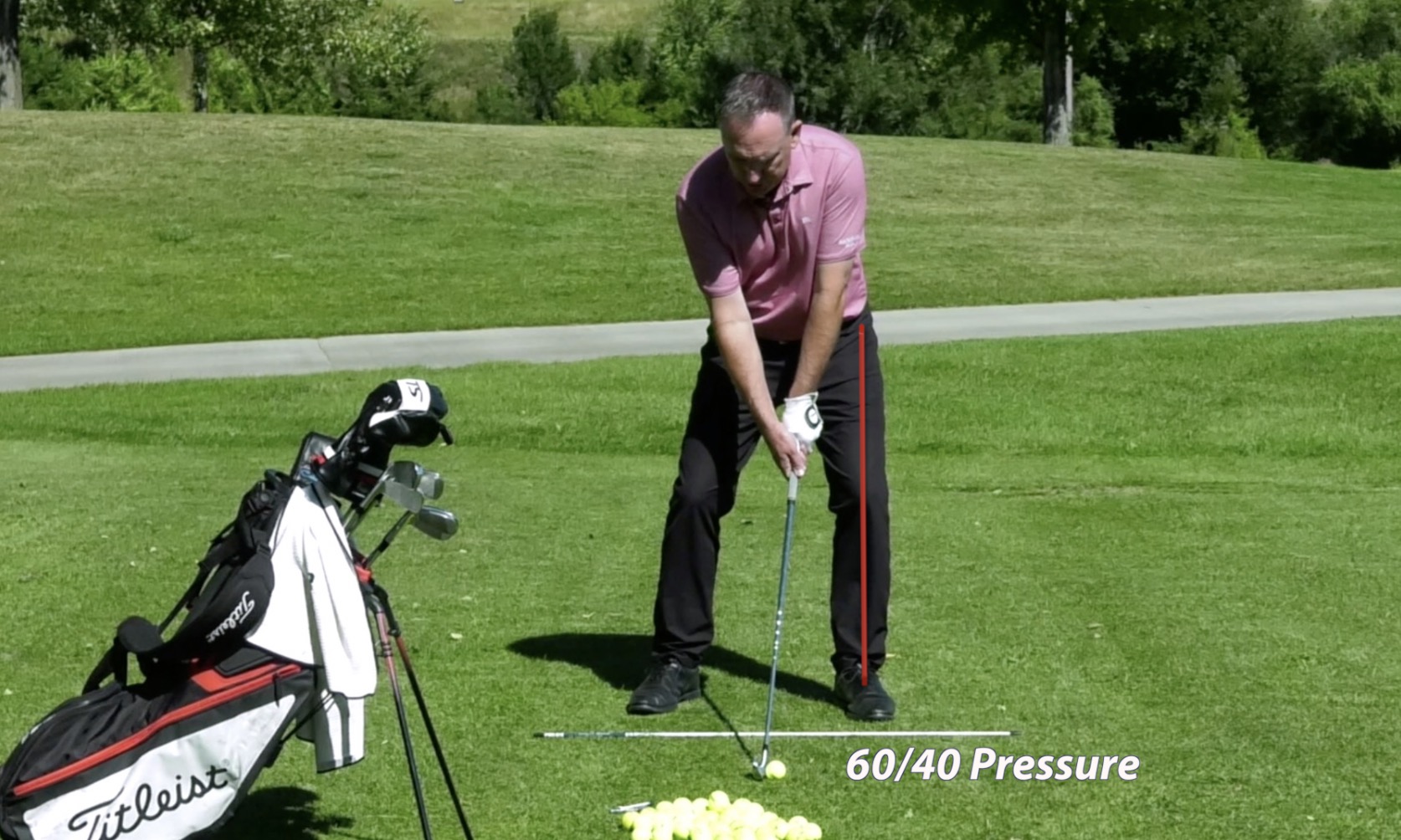
By setting up your golf stance this way, you are able to push your weight into your trail heel on the backswing. We call this “unweighting,” and it helps you find a steady rhythm in your golf swing.
Unweighting also serves as a trigger motion, getting you out of your head and propelling you into the flow of your swing motion.
When you take your golf stance, think about putting about 60% of your weight on your lead foot.
Proper Golf Stance for Drivers
Some of the tips above apply to both your iron golf stance and your driver golf stance. Details such as aim, weight distribution, and proper distance from the ball are pretty much the same whether you’re swinging an iron or a driver.
However, there are some differences between setting up for an iron shot and preparing to hit one off the tee. If you’re not aware of those differences, your drives are going to suffer.
Are you nailing your iron shots pretty regularly but struggling at the tee? You’re about to learn why.
The Goal of Your Driver Golf Stance
As I mentioned earlier, your iron golf stance is designed to help you hit down on the golf ball. When you swing a driver, you have the opposite goal.
You want to hit up on the ball with your driver. Makes sense, right? We tee up the ball so we can get a little underneath it, achieve a decent launch angle, and minimize spin.
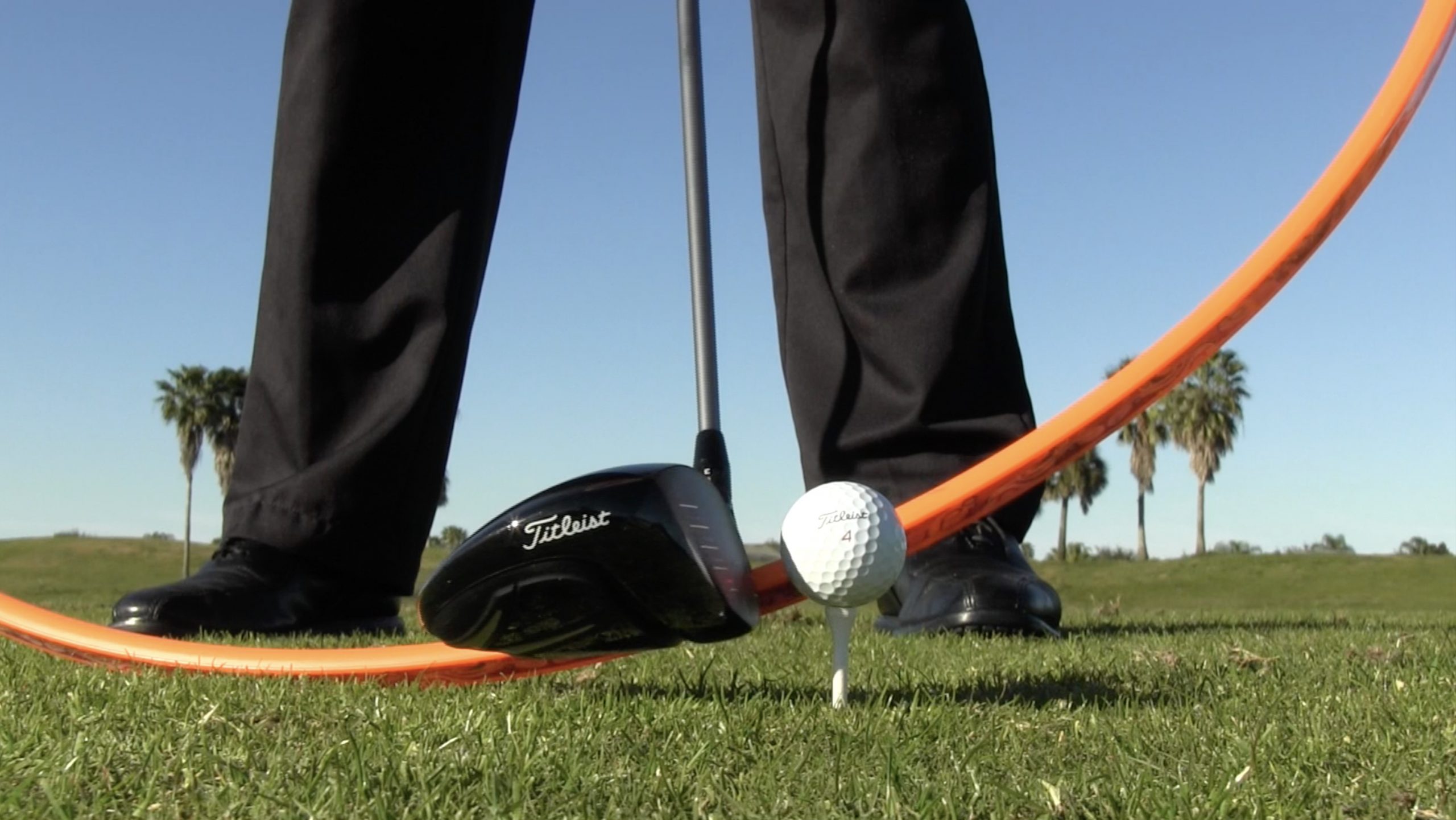
And yet, it’s so easy to forget this all-important goal when we step up to the tee. We get focused on hitting it straight, generating club head speed, and increasing distance. These are all great goals, but they mean nothing if you’re not hitting up on the ball.
And if you’re using an iron golf stance when you approach the tee, guess what.
You’re not hitting up on the ball. You’re hitting down. And you’re getting nowhere.
So, how do you fix it?
Ball Position for Your Driver
Ball position is the key difference between iron and driver setups. As you may recall, the goal of your iron ball position is to make sure you make contact before the low point of your swing.
With a driver, you want impact to occur after the low point, when your club head is on its way back up. This means you want the ball more forward in your golf stance.
To find the sweet spot:
- Stand with your feet together and the golf ball aligned with crack between your feet.
- Step the lead foot towards the target. This should be a very small step.
- Take a much bigger step away from the target with the trail foot. This step should be big enough to achieve that shoulder-width stance. (For your driver stance, you may even want to go a little wider than shoulder-width.)
Now the ball should be more forward in your golf stance, guaranteeing a positive angle of attack.
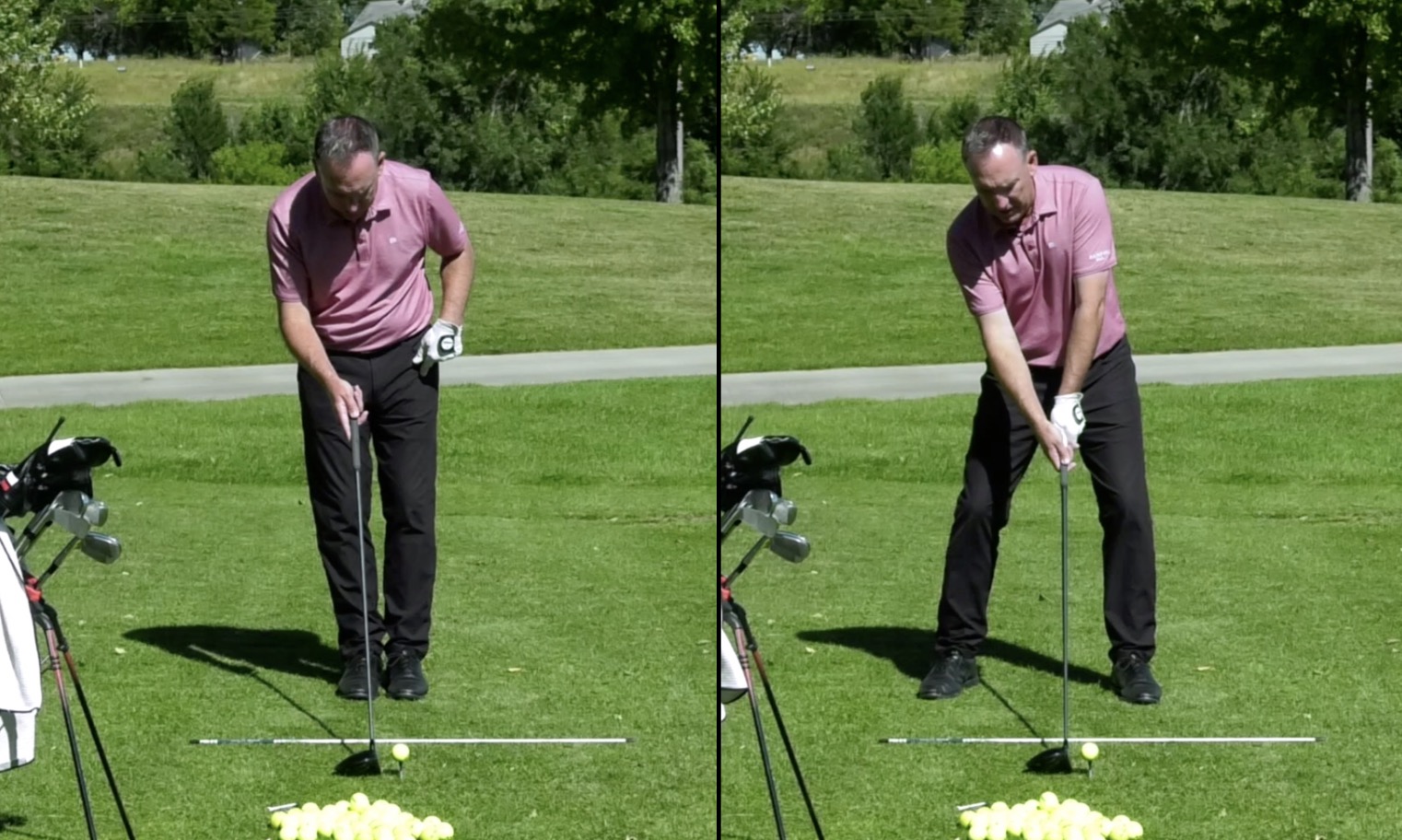
Bonus Tip for Fixing the Slice
If you have a tendency to slice your driver, try these quick fixes:
Raise your lead arm slightly higher than your trail arm.
Tilt your upper body back away from the target.
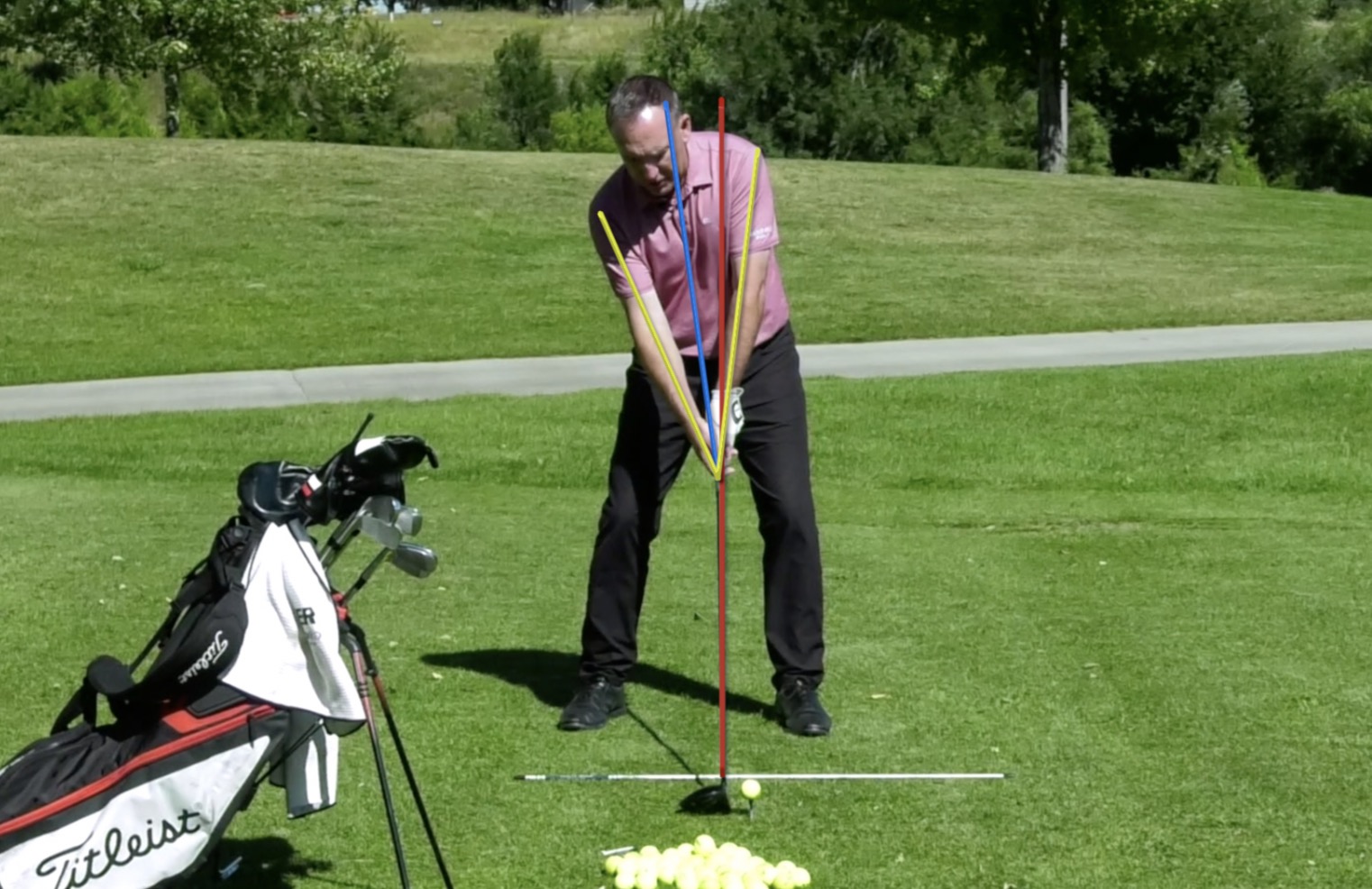
These minor adjustments help you swing from the inside and hit up on the ball. You are much more likely to hit a nice, high draw using this golf posture.
To find the right amount of spine tilt:
- Get into your regular golf stance.
- Hold the golf club against your chest with the club handle running down along the buttons or zipper of your shirt.
- Tilt away from the target until the club head touches your lead knee or thigh.
That’s the perfect amount of upper body tilt. Not too much, not too little.
Biggest Golf Posture Mistakes
As I mentioned earlier, proper golf posture is everything. If you’re slumped, too rigid, or otherwise out of alignment, you’ll see the consequences in your ball flight.
Many of the golf stance tips I’ve already given you help you find your ideal golf posture naturally. But I’d still advise you to take a close look at your stance and make sure you’re not making any errors that could compromise your body rotation or swing motion.
Diagnosing Your Worst Golf Shots
If you’re still not sure why you can’t hit a solid golf shot, see if you can determine why your shots keep veering off course or falling short.
- Is it a matter of poor contact? If so, double-check your golf ball position.
- Are you constantly hitting it too far to the right or left? Spend a little more time perfecting your aim.
- Do you feel off-balance in your golf swing? The problem may be your stance width.
If it’s none of these, it’s time to take a look at your golf posture.
The Most Common Golf Posture Mistakes
The biggest golf posture mistake I see among amateur golfers comes down to body angles. They’re all wrong. There’s too much bend in the neck and too much roundness in the shoulders. This limits body rotation and destroys a golf shot that had great potential otherwise.
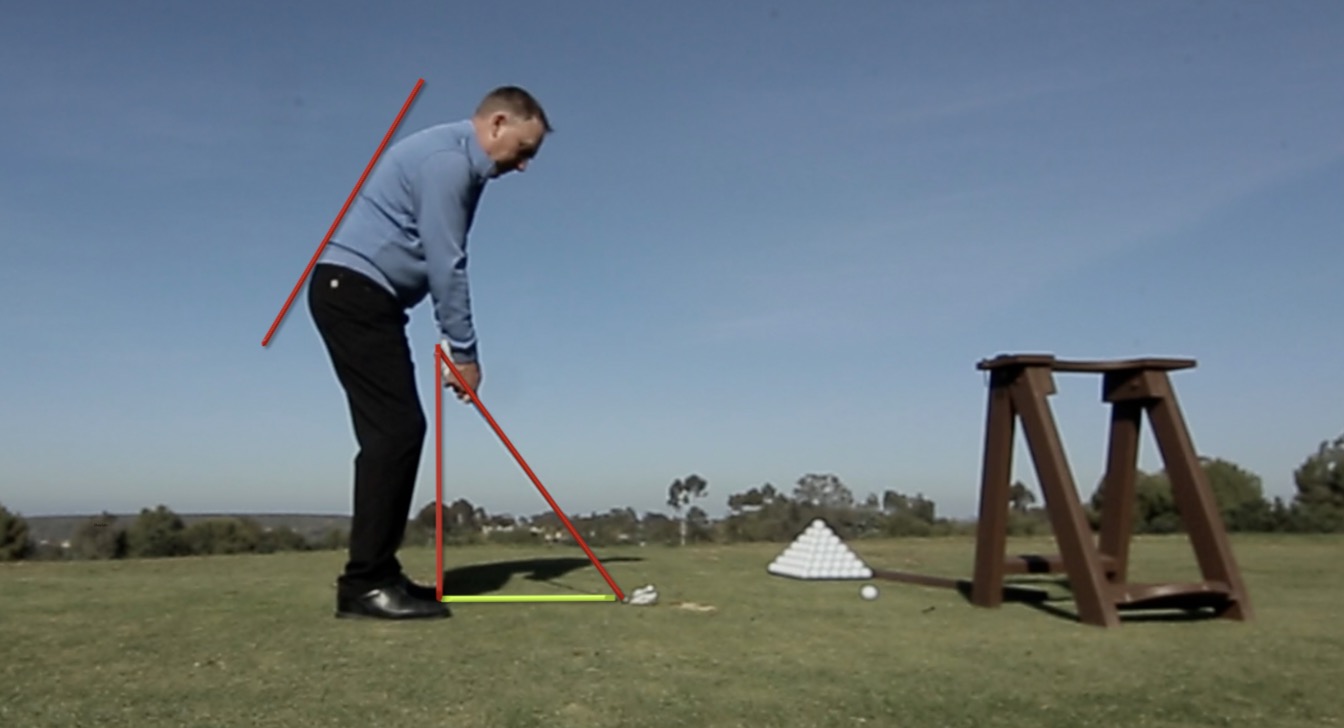
These are the bends we’re looking for in your golf posture:
- Slight bend in the knees
- Forward tilt in the hips
- Relaxed shoulders and spine
- Chin up
To find these ideal body angles naturally:
- Take your golf setup.
- Lift the golf club off the ground and hold it out in front of you.
- Check that your hands are a little bit above belt level.
- Make sure the leading edge of the club head is square to the target.
- Take a look at your golf grip to make sure you’re gripping in the fingers and not in the palm.
- Check for soft arms with a slight bend in the elbows. (You do not want the arms straight and tight.)
- Hinge forward at the hips and lower the club until it touches the ground. If it does not land directly behind the ball, you are either too closer or too far. Adjust as needed.
On paper, this looks like a long checklist. But once you know the routine, it takes all of three seconds to get set up in the ideal golf posture. If you do this regularly, you’ll find that you’ll be able to get into the proper golf stance without the checklist.
After all, this is the goal in all of these tips. Wherever you find an error in your golf stance, take the time to think through your setup until the correct adjustments become your habit.
In time, you’ll make the ideal golf stance a natural part of your game.
Questions? Opinions?
Have these tips helped you? Do you have any questions about golf stance or golf posture? Is there anything here you disagree with?
Share your thoughts in the comments!
For more in-depth golf tips, visit us at GreatGolfTipsNow.com. This golf instruction is completely free and packed with detailed advice to help you play better golf!


Assuming you recommend when hitting Driver that the ball should be lined up with the inside of the heel of the lead foot (or maybe even the toe) – and assuming when you line up initially to the ball with your feet together the ball is already lined up with the heel of the lead foot – why would you move your lead foot toward the target AT ALL, since it is already in line with the lead heel? Why wouldn’t you just keep your lead foot in place and just separate by stepping back with the back foot only?
Thank you for the clarification!
Lee,
That is basically our suggestion. The lead foot works towards the target just slightly. The vast majority of the movement is in the trail foot.
Thanks for the tip that proper weight distribution is important to consider as well when it comes to coming up with the proper golf posture. I’d like to buy Puma golf shoes soon because I will be golfing with my husband this weekend. I think it’s been two years since I last played so I will have to relearn it a bit.
Alice,
This is awesome! Great to see you playing the game.
any drills to stop the over the top, I twist instead of weight shift, making me come across the ball. It happens when I start getting fast or tired ? I will be 75 the 13th of this month. Very seldom can I drive more than 200. And now I’m only hitting my 7 iron around 135-140. But I go to the range and it goes 150to 160. What can I do to take it to the course.
I am 79yrs and since reading and watching your golf tips I have practised your driving and iron tips and now really enjoying my golf as I am hitting the ball longer and straighter without all of the duff shots that I usually had I cannot thank you enough Jim Wilkie
Jim,
Thanks for the kind words! Our team is committed to providing great advice that is geared towards the “experienced” golfer. Have you seen http://www.verticallinegolf.com
Jim,
Thanks for posting. Here is a link to one of our video on distance https://youtu.be/lJCrJUQ00Jk